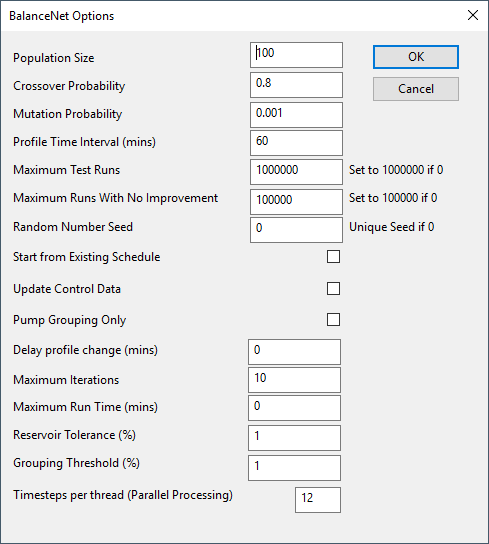BalanceNet Options dialog
This dialog is used to set the options for a BalanceNet run.
The dialog is opened when BalanceNet is chosen as the run type on the Schedule Hydraulic Run view, or when the accompanying Options button is clicked.
| Option | Description |
|---|---|
|
Population Size |
These are genetic algorithm parameters and should be left at their default value. Users familiar with genetic algorithms may wish to use these parameters to fine-tune the optimisation process.
|
|
Crossover Probability |
|
|
Mutation Probability |
|
|
Profile Time Interval |
The time interval used by the BalanceNet optimiser when optimising pumps. A pump’s state cannot change more frequently than this interval. A shorter time step allows more flexibility but it slows optimisation down, so the time interval should be similar to the operational constraints imposed on pumps. |
|
Maximum Test Runs |
The optimisation will not proceed beyond this number. If this limit is reached, the best chromosome (set of schedules) is retained. |
|
Maximum Runs With No Improvement |
The optimisation will stop if a "better" chromosome ("better" meaning lower cost, while obeying constraints) cannot be found after performing this extra number of runs. |
|
Random Number Seed |
The evolution towards a good schedule is governed by random processes of mutation and crossover (see fields at the top of this table). A unique seed (use value zero) should be used so that the system avoids following a repetitive series of events. The seed is reported in the log file and so it can be reused if a repetition is required |
|
Start from Existing Schedule |
Check to use the existing pump schedule as a starting point for the BalanceNet optimiser. If this option is not checked, the BalanceNet optimiser disregards existing schedules. Tip: Starting from an existing schedule may increase the optimisation speed considerably. |
|
Update Control Data |
Check to update the control item used in the current simulation. The Control is updated with the best pump schedule determined by the BalanceNet optimiser. |
|
Pump Grouping Only |
Check to carry out a simulation that comprises pump grouping only, not parameterisation or validation. This option is disabled by default. When enabled, this option provides users with a quick and efficient way of determining pump groups without having to perform a full BalanceNet run which can be time-consuming. In such cases, only the mass balance simulation will be generated. |
| Delay profile change |
Specify the number of minutes from the start of the run before the BalanceNet optimiser can make any changes to pump schedules. When starting from an existing schedule, this is the number of minutes before the optimiser can diverge from the schedule. |
|
Maximum Iterations |
The optimisation is fast because it uses a mass balance model. This model is an approximation to the hydraulic model and is generated automatically. Several iterations might be required in order to achieve convergence between the mass balance and hydraulic models. This parameter sets an upper limit. (1 to 100) |
|
Maximum Run Time |
If this is non-zero then the optimisation will aim to complete within the time specified. The current iteration will complete so the maximum might be exceeded. This is useful in operational environments where a decision must be made within a certain time. The best current schedule will be available. |
|
Reservoir Tolerance |
The convergence between the behaviour of mass balance and hydraulic models is judged by comparing the percentage difference in reservoir levels between the two models. A tolerance of 1% is the default. The range is 0.001% (which is highly exacting) to 100% (which ignores convergence). |
|
Grouping Threshold |
The mass balance model is obtained by parameterising the hydraulic model. The complexity (and speed) of parameterisation depends on the independence of pumps. The grouping threshold percentage concerns the interaction between any two pumps. If there are two pumps, A and B and if we first imagine that pump A is turned on by itself in isolation. Now, let us imagine that pump A is turned on, but this time pump B is on also. What is the percentage impact of B on A? If this falls above the grouping threshold then the two pumps must be parameterised in all combinations. A smaller threshold gives a more accurate but slower optimisation. |
|
Timesteps per thread (Parallel Processing) |
This parameter applies to the multi thread option of BalanceNet. The simulation will run for a certain number of time steps. The ideal is to split these exactly between the available processor cores (for example, if there are 200 time steps on an eight core machine the ideal setting would be 25 steps per thread). |


